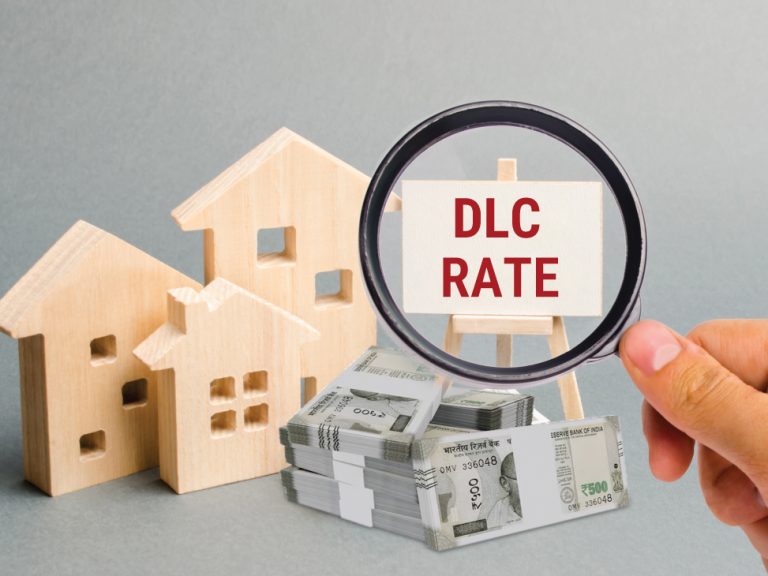Getting home loan is very BASIC now
Get a loan in under 5 mins

When it comes to real estate transactions, understanding the various components that influence property valuation is crucial. One such essential factor is the DLC Rate (District Level Committee Rate). Whether you’re buying or selling property, knowing about DLC rates can significantly impact your financial decisions. In this blog, we’ll dive deep into what DLC rates are, how they are calculated, and why they matter.
Table of Contents
A DLC Rate, also known as the District Level Committee Rate, is a government-determined benchmark used to assess the minimum value of a property for the purpose of calculating stamp duty and registration fees. These rates vary from region to region and are determined by the local government based on the location, type of property, and other relevant factors.
The DLC Rate acts as a safeguard against underreporting of property values, ensuring that the government receives the correct amount of stamp duty, which is crucial for public revenue.
The government DLC rate is calculated by a committee that includes officials from the revenue department, local government bodies, and other relevant authorities. This committee considers various factors, such as:
Once these factors are considered, the committee establishes the DLC value for different categories of properties within a district.
The DLC rate plays a critical role in determining the minimum price at which a property can be registered. If a property’s market price is lower than the DLC value, the stamp duty will still be calculated based on the higher DLC Rate. This means that buyers and sellers need to be aware of the DLC rate to avoid any surprises during the transaction process.
Moreover, understanding the DLC rate information helps in making informed decisions when buying or selling property, as it provides a benchmark for negotiations and pricing.
For those who find the concept of DLC rates complex, a DLC rate calculator can be an invaluable tool. These online calculators allow you to input specific details about the property, such as location, type, and size, to quickly determine the applicable DLC value. This not only simplifies the process of property valuation but also helps in planning your budget for the transaction, including stamp duty and registration fees.
The DLC calculation formula typically involves multiplying the area of the property (in square meters or square feet) by the DLC rate per unit area set by the government.
DLC Value = Area of Property × DLC Rate per sq. meter
For example: If a property has an area of 100 square meters and the government has set the DLC rate at ₹5,000 per square meter, the DLC value would be:
DLC Value=100 sq. meters×₹5,000 = ₹500,000
This formula gives you the minimum value of the property for stamp duty purposes. It is important to note that the DLC rate information can be periodically revised by the government based on changing market conditions.
Several factors can influence the DLC rate:
Understanding the DLC rate is essential for anyone involved in real estate transactions. It helps ensure that you are aware of the minimum property value for stamp duty purposes and provides a benchmark for property pricing. Utilizing a DLC rate calculator can further simplify the process, making it easier to navigate the complexities of property valuation.
Whether you’re a buyer, seller, or simply someone interested in real estate, keeping up with the latest DLC rate information and understanding the DLC calculation formula will empower you to make better financial decisions.
The DLC rate is calculated by the District Level Committee, which considers factors such as the property’s location, type (residential, commercial, industrial, or agricultural), and recent market trends. The rate is set per unit area (e.g., per square meter) and is used to determine the minimum value of a property for stamp duty purposes.
In Rajasthan, the DLC rate is decided by the District Level Committee, which includes officials from the revenue department and local government authorities. This committee periodically reviews and updates the rates based on various factors like market conditions and property transactions in the area.
The “normal” DLC rate varies depending on the region, property type, and local market conditions. There is no fixed standard, as DLC rates are set by the local government and can differ significantly between districts and property categories.
DLC count is typically calculated by multiplying the area of the property (in square meters or square feet) by the DLC rate per unit area. This gives you the property’s minimum value as per the government’s assessment for stamp duty and registration purposes.
The DLC rate in India varies widely depending on the location, type of property, and local government policies. Each state or district has its own set of DLC rates, which are periodically revised by the local District Level Committees to reflect current market conditions.
Published on 13th August 2024